Crystal reports is one of the most widely used reporting component in Visual Studio. But this time it goes missing from the final release of Visual Studio 2010. Crystal Reports for Visual Studio 2010 is now available for download to all the Visual Studio 2010 users and is for free of cost as always.
Download Links:
Download Crystal Reports for Visual Studio 2010
Getting Started with Crystal Reports for Visual Studio 2010
Tutorials for Crystal Reports for Visual Studio 2010
Related Areas
I was just surfing the net in search for some fundoo tutorial on WPF and by chance (I don’t meant to visit that site), I get this class which I feel is pretty helpful. A simple wrapper class to conver time. the class allows you to convert:
This can be pretty usefull. The class is as follows:
using System;
public static class TimeSpanUtil
{
#region To days
public static double ConvertMillisecondsToDays(double milliseconds)
{
return TimeSpan.FromMilliseconds(milliseconds).TotalDays;
}
public static double ConvertSecondsToDays(double seconds)
{
return TimeSpan.FromSeconds(seconds).TotalDays;
}
public static double ConvertMinutesToDays(double minutes)
{
return TimeSpan.FromMinutes(minutes).TotalDays;
}
public static double ConvertHoursToDays(double hours)
{
return TimeSpan.FromHours(hours).TotalDays;
}
#endregion
#region To hours
public static double ConvertMillisecondsToHours(double milliseconds)
{
return TimeSpan.FromMilliseconds(milliseconds).TotalHours;
}
public static double ConvertSecondsToHours(double seconds)
{
return TimeSpan.FromSeconds(seconds).TotalHours;
}
public static double ConvertMinutesToHours(double minutes)
{
return TimeSpan.FromMinutes(minutes).TotalHours;
}
public static double ConvertDaysToHours(double days)
{
return TimeSpan.FromHours(days).TotalHours;
}
#endregion
#region To minutes
public static double ConvertMillisecondsToMinutes(double milliseconds)
{
return TimeSpan.FromMilliseconds(milliseconds).TotalMinutes;
}
public static double ConvertSecondsToMinutes(double seconds)
{
return TimeSpan.FromSeconds(seconds).TotalMinutes;
}
public static double ConvertHoursToMinutes(double hours)
{
return TimeSpan.FromHours(hours).TotalMinutes;
}
public static double ConvertDaysToMinutes(double days)
{
return TimeSpan.FromDays(days).TotalMinutes;
}
#endregion
#region To seconds
public static double ConvertMillisecondsToSeconds(double milliseconds)
{
return TimeSpan.FromMilliseconds(milliseconds).TotalSeconds;
}
public static double ConvertMinutesToSeconds(double minutes)
{
return TimeSpan.FromMinutes(minutes).TotalSeconds;
}
public static double ConvertHoursToSeconds(double hours)
{
return TimeSpan.FromHours(hours).TotalSeconds;
}
public static double ConvertDaysToSeconds(double days)
{
return TimeSpan.FromDays(days).TotalSeconds;
}
#endregion
#region To milliseconds
public static double ConvertSecondsToMilliseconds(double seconds)
{
return TimeSpan.FromSeconds(seconds).TotalMilliseconds;
}
public static double ConvertMinutesToMilliseconds(double minutes)
{
return TimeSpan.FromMinutes(minutes).TotalMilliseconds;
}
public static double ConvertHoursToMilliseconds(double hours)
{
return TimeSpan.FromHours(hours).TotalMilliseconds;
}
public static double ConvertDaysToMilliseconds(double days)
{
return TimeSpan.FromDays(days).TotalMilliseconds;
}
#endregion
}
Last month I have blogged on how you can integrate OpenID login support in your ASP.NET aplication. Some of the reader requested me that it would be better if I could show how you can implement membership and roles with OpenID authentication. It doesn’t seems easy in the first place, because you will require a bit more informaton from the user like his name and e-mail address. So, what I am trying to show you here is how you can gather information of the user who has logged in with OpenID and then you can use that information to set roles and membership for your website. I am just extending the old sample project from my previous post to show you how you can get some of the basic information of the user including their e-mail address.
I assume you have downloaded the complete solution from my previous post with OpenID login support, download here if you haven’t yet. There is nothing new to be added in the application, instead we just need to change some properties of the OpenID control we have used. Click the control and press F4 to get the properties up. Set the properties to Request to make sure that whenever a user sign-in with OpenID the API also makes a request to the service provider to get the information of the user signing in. I have request some of the basic information of the user by making them Request. It all depends on the author of the code what information he wants to see/require when the user gets logged in.
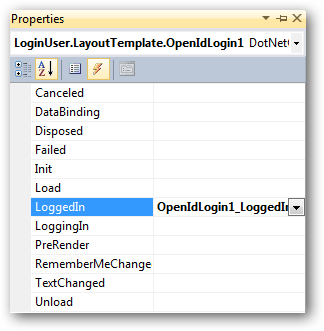
Now as you have set the properties, it’s time to make a request to the provider and get the infromation. You need to do something special to get the details, sign-in as normally you would have done, but notice while re-directing the page URL will be something like this (only for a while):
.............&openid.sreg.required=&openid.sreg.optional=nickname%2Cfullname%2Cdob%2Cgender%2Ccountry
Notice the last few options in the query string is requesting the parameters we have “Requested”. But you should also know that the values will be null if the user has not filled up his Persona (Personal Details). If you try to fetch the details of the user, you will get a null value. So, it’s pretty necessary that the user who has logged in using the OpenID should have his personal details filled up at the provider’s end. This is how my personal details look like at OpenID (website) login.
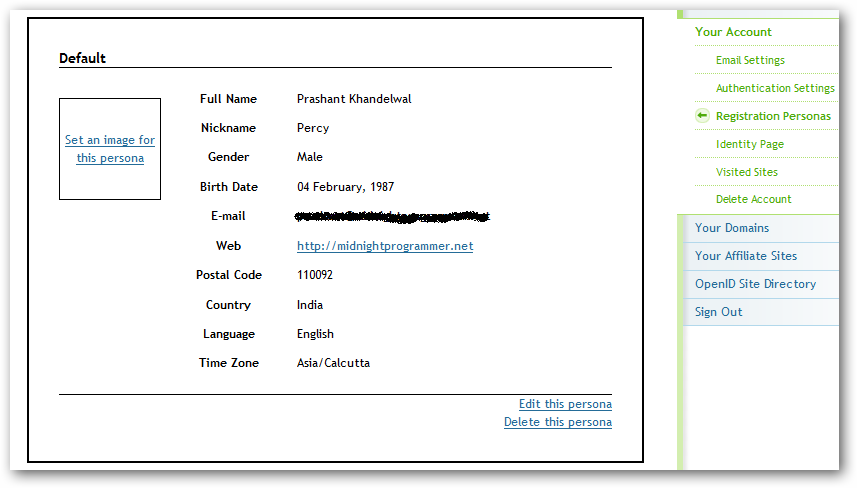
Personas are actually the information of the user which will be delivered to the site or application where the user has logged in using OpenID. You can add/modify/delete a personas. Once you have the persona of the logged in user you can:
I’ve already demonstrate in the above steps on how to set the OpenID user control to request the user details or personas.
What else I need to do
In Visual Studio, select the OpenID control and press F4 to get the properties. Under method section double-click the LoggedIn method (The method name describes itself).

In this method, read the response and set it to the session variable. Give a name to the sesison variable.
protected void OpenIdLogin1_LoggedIn(object sender, DotNetOpenAuth.OpenId.RelyingParty.OpenIdEventArgs e)
{
Session["OpenID"] = e.Response;
}
When the user is successfully authenticated by the provider, user is re-directed to the default home page. Therefore, we need to handle the response on the home page. Add these two namespaces on the page code-behind.
using DotNetOpenAuth.OpenId.RelyingParty; using DotNetOpenAuth.OpenId.Extensions.SimpleRegistration;
I am using the page load method so as to get the details and display it front of the user, you can also set the same details to fill up a registration form. To read the response from the session variable use the IAuthenticationResponse to read store the session value and then read it with GetResponse<ClaimResponse> method. Below is the complete code for your default.aspx page or the page you want the user to be re-directed. I have store the values in the public variables as I want to show the user details on the default page.
using System;
using System.Collections.Generic;
using System.Linq;
using System.Web;
using System.Web.UI;
using System.Web.UI.WebControls;
using DotNetOpenAuth.OpenId.RelyingParty;
using DotNetOpenAuth.OpenId.Extensions.SimpleRegistration;
namespace DOTNETOAUTH
{
public partial class _Default : System.Web.UI.Page
{
IAuthenticationResponse OResponse;
public string UserName = string.Empty;
public string Gender = "No Gender Specified";
public string Country = string.Empty;
public string Nick = string.Empty;
public string Bday = string.Empty;
protected void Page_Load(object sender, EventArgs e)
{
try
{
OResponse = (IAuthenticationResponse)Session["OpenID"];
var details = OResponse.GetExtension<ClaimsResponse>();
UserName = details.FullName;
//email = details.Email;
Gender = details.Gender.ToString();
Country = details.Country;
Nick = details.Nickname;
Bday = details.BirthDate.ToString();
}
catch { }
}
}
}
If any of the above values are not present in the user persona , it will result in an error, so make sure you have handle the exceptions properly. This is it, once you have the details you can use to store the details in the database, set roles and membership to the user logins. I have skip the part to set user roles and membership, once we have the user information we can use that information to set roles or just save the information in the database.

Download: DOTNETOAUTH - UserData.zip (552.20 kb)
I have found many web developers seeking for help to upload a file in AJAX style, I am not a web developer but among the list of people who used to search the web for some control, way or a workaround to do this. I found a .NET control to do this, but like all good controls….it wasn’t free. But the control worth it.
But now we have an excellent open source plugin called Uploadify. I have been using it for sometime and thought I should now blog and spread a word about it. To implement in your ASP.NET project is simple. Download the latest version of Uploadify from its official site here.
Take a look at the downloaded files. Actually, I need NOT to explain it again to you because the download itself has a PDF file which makes it really simple to understand the working and usage of the plugin. If you need to take a look how this plug-in works, then the best place to look at the demo page at the uploadify page here.
I also compiled a small apllication with ASP.NET to see it in action with ASP.NET
NOTE: The code below I have uploaded is not written by me, I have just compiled a bunch of files under one hood to get it working.
Download: JqueryUploadify.zip (229.05 kb)
A new view engine is introduced in ASP.NET MVC 3 called RAZOR. You can download Preview 1 from Microsoft’s download center and get it running on your machine to check the new features in MVC 3. Just in case if you are thinking that installing MVC 3 will mess your current MVC 2 installation….No, it won’t. I came across a Webcamp video where Phil Haack with James Senior demonstrate this view engine. My this post is also based on the same talk.
So when you install MVC 3 Preview 1 on your machine, jump start by creating a new project in Visual Studio 2010. You will not be able to use this view engine with .NETFX 3.5 (SP1).
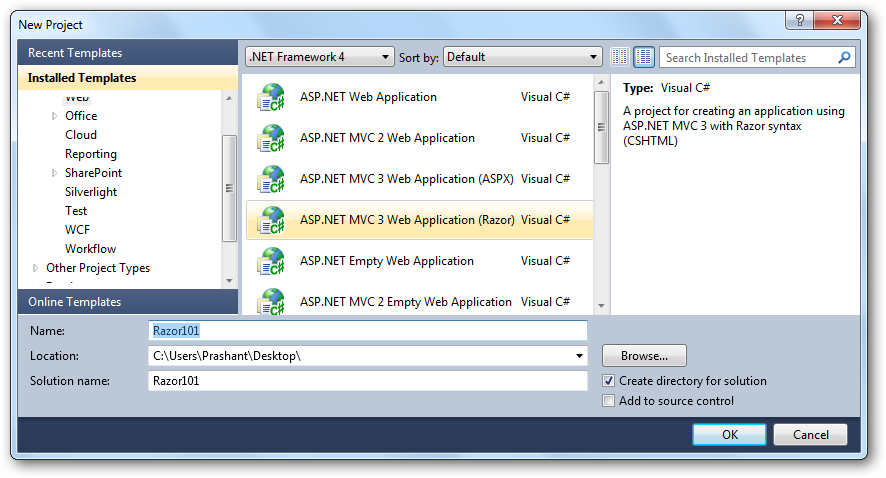
Now when you select new project and under Web templates you will now see ASP.NET MVC 3 application twice. The one template with (ASPX) is using normal web forms as your view engine and the other one with (Razor) is the new view engine. This is only for preview 1, these options will not be present in the final release of the MVC 3, instead you will have an oprion to select the view engine for your application later, I am not very sure how, but it will be more likely the way you select tests.
Time to check the Solution Explorer. No .aspx files only .cshtml
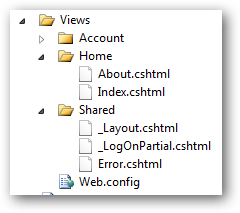
The drawback in Preview 1 is that there is no syntax highlighting and no intellisense. Now that would have made you think “OMG! how am I going to write the code now!?”. But Razor is easy and more over it too light-weight, more then I thought before I used it. Check out Index.cshtml, the markup code looks like this.
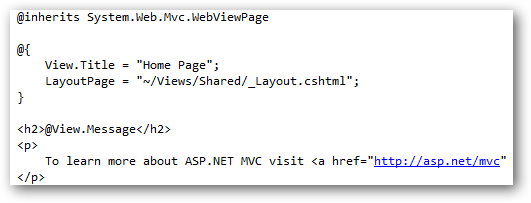
Time to take a look at Home Controller. Take a look at the Index() action method, the syntax is bit different with the one we have used previously.
public ActionResult Index()
{
ViewModel.Message = "Welcome to ASP.NET MVC!";
return View();
}
The line ViewModel.Message = “Welcome to ASP.NET MVC!”; is equivalent to:
public ActionResult Index()
{
ViewData["Message"] = "Welcome to ASP.NET MVC!";
return View();
}
The ViewModel basically is of type dynamic which means that its operations will be resolved at runtime. Hover your cursor over ViewModel and Message to know about it.


If you need to show some addtional information related your current project you can set it too with ease. In the Index method you can add antoher line like this which says something about your project:
NOTE: *As ViewModel is of Dynamic type, so when you press dot (.) after writing ViewModel don’t expect that something will come up and as said before all expressions will be resolved at runtime.*
public ActionResult Index()
{
ViewModel.Message = "Welcome to ASP.NET MVC!";
ViewModel.AboutApp = "This is a sample ASP.NET MVC 3 Preview 1 application!";
return View();
}
To show this message on the Index view you will just call it by prefixing it with ’@’ symbol. To show the value on the page you simply write below line and prefix it with @ symbol(If you say this is simple, I would rather prefer to say it effortless).
@View.Message @View.AboutApp
Moving further, add a new class called Contacts (or what ever name you like) with 3 peoperties.
public class Contacts
{
public string Name{ get; set; }
public int Age{ get; set; }
public string Email { get; set; }
}
Moving back to the HomeController add the below lines of code to the Index action method.
var ctc = new Contacts[] {
new Contacts{Name="Prashant", Age = 23},
new Contacts{Name="Arvind", Age = 24},
new Contacts{Name="Max", Age = 23}
};
The view should not be empty this time. And therefore your Index action method return the Contacts we have just created.
public ActionResult Index()
{
ViewModel.Message = "Welcome to ASP.NET MVC!";
ViewModel.AboutApp = "This is a sample ASP.NET MVC 3 Preview 1 application!";
var ctc = new Contacts[] {
new Contacts{Name="Prashant", Age = 23},
new Contacts{Name="Arvind", Age = 24},
new Contacts{Name="Max", Age = 23}
return View(ctc);
};
}
This time also Razor makes it simple to view the the data you returned from the controller. In the Index.cshtml you can do it pretty simply and you will still have a pretty looking markup of the view page. Create a list of contacts you have just created. As they are in a set of array, we can then enumerate the array with a foreach loop and show it on the page.
<ul>
@foreach (var c in Model){
<li> My name is @c.Name and I am @c.Age years old. </li>
}</ul>
You can easily get the data in a jiffy without writing a lot of markup. No problem in concatenating the data, the @ symbol and MVC compiler is pretty intelligent and does this for us. So what if we want to add e-mail addresses also. How this view engine will handle this ambiguity? Well let see. Just add an e-mail property to the array of contacts.
var ctc = new Contacts[] {
new Contacts{Name = "Prashant", Age = 23, Email = "prashant@midnightprogrammer.net"
}
And on the view page the line will be something like this
<ul>
@foreach (var c in Model){
<li> My name is @c.Name and I am @c.Age years old. You can email me at @c.Email.</li>
}</ul>
Hit F5 and see it by yourself. There are lot of features described by Scott Guthrie and Phil Haack on their blog. Well I can go on writing and writing about Razor, so I think I should take a pause now and you can go to below links for more deep information about Razor view engine and to know what’s new in the upcoming release of ASP.NET MVC 3.
Recommend Reading: